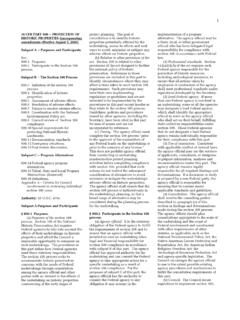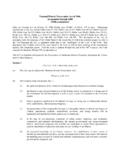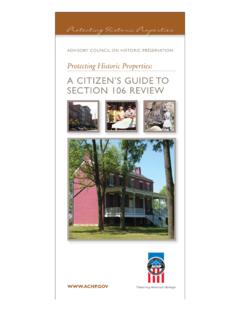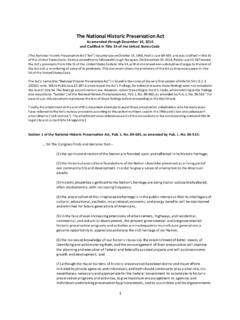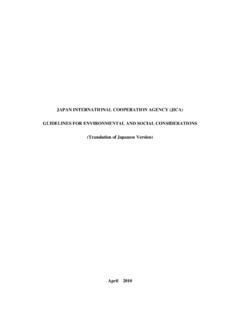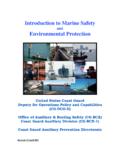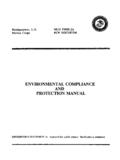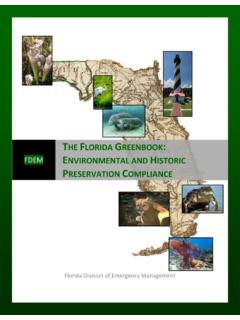Transcription of 36 CFR PART 800 -- PROTECTION OF …
1 136 CFR PART 800 -- PROTECTION OF HISTORIC PROPERTIES (incorporating amendments effective August 5, 2004) Subpart A -- Purposes and Participants Sec. Purposes. Participants in the Section 106 process. Subpart B -- The Section 106 Process Initiation of the section 106 process. Identification of historic properties. Assessment of adverse effects. Resolution of adverse effects. Failure to resolve adverse effects. Coordination with the National Environmental Policy act. Council review of Section 106 compliance. Special requirements for protecting National Historic Landmarks. Documentation standards. Emergency situations. Post-review discoveries. Subpart C -- Program Alternatives Federal agency program alternatives. Tribal, State and Local Program Alternatives. (Reserved) Definitions. Appendix A Criteria for Council involvement in reviewing individual section 106 cases Authority: 16 470s.
2 Subpart A-Purposes and Participants Purposes. (a) Purposes of the section 106 process. Section 106 of the National Historic Preservation Act requires Federal agencies to take into account the effects of their undertakings on historic properties and afford the Council a reasonable opportunity to comment on such undertakings. The procedures in this part define how Federal agencies meet these statutory responsibilities. The section 106 process seeks to accommodate historic preservation concerns with the needs of Federal undertakings through consultation among the agency official and other parties with an interest in the effects of the undertaking on historic properties, commencing at the early stages of project planning. The goal of consultation is to identify historic properties potentially affected by the undertaking, assess its effects and seek ways to avoid, minimize or mitigate any adverse effects on historic properties.
3 (b) Relation to other provisions of the act. Section 106 is related to other provisions of the act designed to further the national policy of historic preservation. References to those provisions are included in this part to identify circumstances where they may affect actions taken to meet section 106 requirements. Such provisions may have their own implementing regulations or guidelines and are not intended to be implemented by the procedures in this part except insofar as they relate to the section 106 process. Guidelines, policies and procedures issued by other agencies, including the Secretary, have been cited in this part for ease of access and are not incorporated by reference. (c) Timing. The agency official must complete the section 106 process prior to the approval of the expenditure of any Federal funds on the undertaking or prior to the issuance of any license.
4 This does not prohibit agency official from conducting or authorizing nondestructive project planning activities before completing compliance with section 106, provided that such actions do not restrict the subsequent consideration of alternatives to avoid, minimize or mitigate the undertaking's adverse effects on historic properties. The agency official shall ensure that the section 106 process is initiated early in the undertaking's planning, so that a broad range of alternatives may be considered during the planning process for the undertaking. Participants in the Section 106 process. (a) Agency official. It is the statutory obligation of the Federal agency to fulfill the requirements of section 106 and to ensure that an agency official with jurisdiction over an undertaking takes legal and financial responsibility for section 106 compliance in accordance with subpart B of this part.
5 The agency official has approval authority for the undertaking and can commit the Federal agency to take appropriate action for a specific undertaking as a result of section 106 compliance. For the purposes of subpart C of this part, the agency official has the authority to commit the Federal agency to any obligation it may assume in the implementation of a program alternative. The agency official may be a State, local, or tribal government official who has been delegated legal responsibility for compliance with section 106 in accordance with Federal law. (1) Professional standards. Section 112(a)(1)(A) of the act requires each Federal agency responsible for the PROTECTION of historic resources, including archeological resources, to ensure that all actions taken by employees or contractors of the agency shall meet professional standards under regulations developed by the Secretary.
6 (2) Lead Federal agency. If more than one Federal agency is involved in an undertaking, some or all the agencies may designate a lead Federal agency, which shall identify the appropriate official to serve as the agency official who shall act on their behalf, fulfilling their collective responsibilities under section 106. Those Federal agencies that do not designate a lead Federal agency remain individually responsible for their compliance with this part. (3) Use of contractors. Consistent with applicable conflict of interest laws, the agency official may use the services of applicants, consultants, or designees to prepare information, analyses and recommendations under this part. The agency official remains legally responsible for all required findings and determinations. If a document or study is prepared by a non-Federal party, the agency official is responsible for ensuring that its content meets applicable standards and guidelines.
7 (4) Consultation. The agency official shall involve the consulting parties described in paragraph (c) of this section in findings and determinations made during the section 106 process. The agency official should plan consultations appropriate to the scale of the undertaking and the scope of Federal involvement and coordinated with other requirements of other statutes, as applicable, such as the National Environmental Policy Act, the Native American Graves PROTECTION and Repatriation Act, the American Indian Religious Freedom Act, the Archeological Resources PROTECTION Act and agency-specific legislation. The Council encourages the agency official to use to the extent possible existing agency procedures and mechanisms to fulfill the consultation requirements of this part. (b) Council. The Council issues regulations to implement section 106, 2provides guidance and advice on the application of the procedures in this part, and generally oversees the operation of the section 106 process.
8 The Council also consults with and comments to agency officials on individual undertakings and programs that affect historic properties. (1) Council entry into the section 106 process. When the Council determines that its involvement is necessary to ensure that the purposes of section 106 and the act are met, the Council may enter the section 106 process. Criteria guiding Council decisions to enter the section 106 process are found in appendix A to this part. The Council will document that the criteria have been met and notify the parties to the section 106 process as required by this part. (2) Council assistance. Participants in the section 106 process may seek advice, guidance and assistance from the Council on the application of this part to specific undertakings, including the resolution of disagreements, whether or not the Council is formally involved in the review of the undertaking.
9 If questions arise regarding the conduct of the section 106 process, participants are encouraged to obtain the Council's advice on completing the process. (c) Consulting parties. The following parties have consultative roles in the section 106 process. (1) State historic preservation officer. (i) The State historic preservation officer (SHPO) reflects the interests of the State and its citizens in the preservation of their cultural heritage. In accordance with section 101(b)(3) of the act, the SHPO advises and assists Federal agencies in carrying out their section 106 responsibilities and cooperates with such agencies, local governments and organizations and individuals to ensure that historic properties are taking into consideration at all levels of planning and development. (ii) If an Indian tribe has assumed the functions of the SHPO in the section 106 process for undertakings on tribal lands, the SHPO shall participate as a consulting party if the undertaking takes place on tribal lands but affects historic properties off tribal lands, if requested in accordance with (c)(1), or if the Indian tribe agrees to include the SHPO pursuant to (f)(3).
10 (2) Indian tribes and Native Hawaiian organizations. (i) Consultation on tribal lands. (A) Tribal historic preservation officer. For a tribe that has assumed the responsibilities of the SHPO for section 106 on tribal lands under section 101(d)(2) of the act, the tribal historic preservation officer (THPO) appointed or designated in accordance with the act is the official representative for the purposes of section 106. The agency official shall consult with the THPO in lieu of the SHPO regarding undertakings occurring on or affecting historic properties on tribal lands. (B) Tribes that have not assumed SHPO functions. When an Indian tribe has not assumed the responsibilities of the SHPO for section 106 on tribal lands under section 101(d)(2) of the act, the agency official shall consult with a representative designated by such Indian tribe in addition to the SHPO regarding undertakings occurring on or affecting historic properties on its tribal lands.
